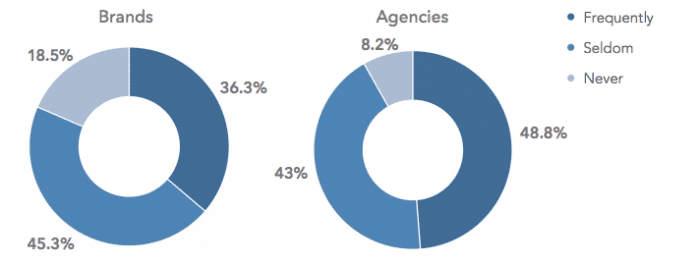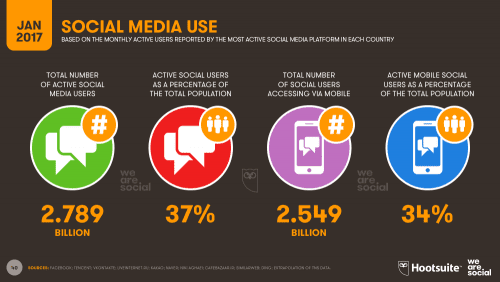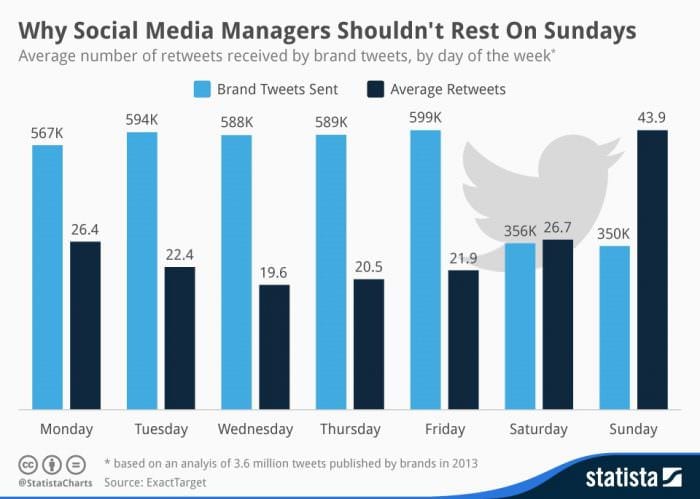Find the most effective ways to increase social ROI
So, you know that social media is a critical part of your customers’ lives. You’ve got a social media plan going, but you’re not seeing great results just yet. Perhaps you are still figuring out the best channels for reaching your target audience, or maybe you’re still learning about what content is most engaging.
Download FREE Resource – 10 common social media marketing mistakes
Our actionable guide to avoiding common social media marketing mistakes to help you avoid the pitfalls that limit engagement with your target audience.
Access the
If you’re looking to improve the effectiveness of your social media operations and increase your ROI, here are the things you must pay attention to.
1. You can't improve what you don't measure
Virtually all businesses are using social media these days, but most companies aren’t getting a great ROI. A major reason why ROI for social is so low is that brands aren’t measuring their social media performance. According to Simply Measured’s most recent State of Social Media Marketing report, nearly 1 in 5 of the brands surveyed indicated they never had conversations about social ROI.

After all, you can’t improve what you don’t measure. You should outline why you are using social media - is it for brand awareness, thought leadership, lead generation, lead nurturing or customer retention? What goals do you want to achieve with social media marketing? Do you want to drive a specific number of users to your website? Do you want to nurture your existing leads? Once you answer these questions, you can use metrics to measure your success.
A Demand Marketing & Socedo study found that when social media goals are identified and tools are put in place to measure the metrics, social media ROI triples.
2. Make sure you know who is engaging with your content
According to a special report from We Are Social and Hootsuite, about 2.8 billion people in the world use social media at least once each month. 91% of those people use a mobile device to access social networks and 34% of the population are active mobile social users. Understanding what types of devices your audience is using can help you better understand their mindset. For example, individuals viewing your brand’s social media content on mobile devices tend to be younger, and they tend to skim over posts very quickly.

If you don’t know who is engaging with your content, you won’t have any context behind your metrics. You can go into the analytics of different social networks to get other demographic data on who is engaging with your content.
3. Make sure your content on social media resonates with your target audience
Low engagement with social media posts is one of the biggest problems for brands that are just starting out. If your brand isn’t getting the social engagement you are looking for, it’s likely because you are not reaching your target audience – the people who are good leads for your business – with your content.
To make sure your content resonates with your target audience, you want to have a thorough understanding of what your target audience is doing online and what types of content they are engaging with.
Are there particular industry influencers that are gaining traction with your customers and prospects? What are they posting about? Which of their posts get the most reactions from their followers? Who are they engaging with? These are the types of clues you should be looking for.
You can learn your target audience’s interests and pain points through social media listening. By analyzing what other people in your ecosystem are talking about, and which of their posts are getting the most engagement, you can gain insights to figure out what type of content would work well for you.
There are lots of social media monitoring tools that can help you surface mentions of your brand, competitors, product and anything else you might consider relevant to your business.
- Reddit Keyword monitor pro
- Hootsuite insights
- Buffer
- Crowd Analyzer
- Google Alerts
You can use tools like BuzzSumo to analyze what content performs best for any topic and which pieces get the most shares on a particular social network.
Once you’ve captured some insights into your customers, competitors, and industry influencers, you can use tools like Socedo to help you efficiently reach people on Twitter who are relevant to your business. Socedo lets you find your target audience based on keywords in their job titles and in their tweets, mentions of certain brands and influencers, as well as the handles they follow.
The tool will automatically follow people who show interest in your space, and it can send direct messages to those who follow you back. Using this workflow, you get on your target prospects’ radar, gain new Twitter followers and ensure that they see your content.
4. Make sure you are posting frequently enough that your content is seen by your target audience
Have you ever seen a Twitter feed that only posts a few times a month? You probably weren't tempted to stick around and follow that account. It can be difficult to build a social media following or learn which tactics are effective if you don’t post frequently enough. You need to post on a regular basis--ideally multiple times a day --to gauge what is working and what isn’t. If you aren’t posting enough, your target audience simply won’t see your content.
Neil Patel has run some experiments on how the number of posts on Twitter impacts traffic to his website. He ran one test where he only posted one Tweet per day. During this seven-day period, he saw an average of 747 visitors for the week. But when he increased the number of posts to 40 a day, traffic went up to 5,623 visitors. The only difference was posting once a day versus posting 40 times a day. Neil mentions that you should post as frequently as possible, as long as you have enough content.
You shouldn’t neglect a single day of the week either. Stats from Statista Charts show that brands send out the least number of tweets on Sunday even though the day is a particularly strong one for social media engagement:

You also want to make sure that you are posting multiple types of content on your profile. You should almost never post a tweet with just text and no associated image or gif or video.
5. Are you utilizing social lead generation and social lead nurturing tools?
Social media is now over 10% of the average company’s marketing budget. In order to improve ROI, that money must actually generate high quality leads and customers. Fortunately, you don’t have to manually scour social networks for leads on your own. There is marketing software such as that from Socedo, which can automatically find new leads for you by matching Twitter posts and profile information with your buyer personas. Socedo lets you reach out to people who fit your criteria on a continuous basis by visiting people’s profiles, following people and then sending customized direct messages to those who follow you back. You can sync new contacts with any social engagement status (i.e. people who followed you) into your marketing database or CRM.
For finding leads on LinkedIn, you can use tools like Dux-Soup, which can visit thousands of LinkedIn profiles on your behalf, tag profiles and add new with contact data from LinkedIn into your CRM.
6. Social media should be used to nurture your existing customers
Social media isn’t just for finding new customers; it can also be used for nurturing your current customers. Make sure that you are cultivating customer loyalty and building relationships by recognizing the achievements and successes of your current customers.
On social media, you can answer questions from your community and teach them better ways of using your product. Customers who are love your product are likely to recommend your business to their network, which is essentially free marketing.
7. Schedule experiments into your social media cadence
The worst thing you could do for any social media program is to let things go on autopilot. Social media is a constantly evolving space, and new trends and features on Facebook, Twitter, and Instagram present new ways for marketers to use these platforms. Make sure you try new things each month.
For example, you might try adding Click-to-Tweet throughout your blog articles to boost shares, or A/B testing each post, or try out how tweeting the same content more than once impacts performance.
8. Integrate Behavioral Insights from Social Media Into Your Core Marketing and Sales Workflows
By tracking how people (both new visitors and existing leads) are engaging with your social media content and content from others in your ecosystem and adding this information into your marketing automation or CRM system, you can improve the way your team is nurturing and scoring leads, and ensure that you’re identifying all sales-ready leads in a timely warmer.
My marketing team is using Oktopost to publish content on social media. Oktopost has a native integration with our marketing automation platform - Marketo. By setting up this integration, we’re able to sync social lead information with Marketo and update lead records with precise lead source information, including which social network or social profile a click or conversion came from.
By setting up this integration, we can see which specific social media posts are driving engagement and conversions, and how leads are interacting with our own social media content over the course of their buying journey. This data also allows our email marketing team to create workflow triggers in Marketo and categorize leads into dedicated topical buckets for lead nurturing.
In addition, we have started to lead score clicks from our social media posts to our website the same way we score email clicks. A social media click gets 15 points in our behavioral lead scoring system. This allows us to identify hot leads in our database and pass them over to the sales team in a timely manner.
Last but not least, we’re able to understand the impact social media is making on our pipeline. We’ve found that conversion rate from socially engaged leads in our database is 73% higher than leads who only engaged with our emails. Furthermore, socially engaged leads generated more revenue for us compared to non-socially engaged leads.
Parting Thoughts
Developing an effective social media strategy doesn’t have to be overly complex. Start with your most important goals, and select the best tactics for meeting these goals. By using social insights to learn more about your target audience, and using your performance data to improve your tactics over time, you are well on your way towards improving your social media ROI.
Download FREE Resource – 10 common social media marketing mistakes
Our actionable guide to avoiding common social media marketing mistakes to help you avoid the pitfalls that limit engagement with your target audience.
Access the

Thanks to Jingcong Zhao for sharing their advice and opinion in this post. Jingcong is currently leading Content Marketing at
Socedo, Socedo has created a SaaS platform that helps B2B marketers grow their Twitter presence, drive website traffic and add new leads from social media into their marketing database, all with minimal time investment on their part. Jingcong Zhao is responsible for driving content strategy at Socedo and collaborates with the marketing team and external stakeholders to develop content assets across the entire funnel. You can follow her on
Twitter or connect on
LinkedIn.






 Thanks to Jingcong Zhao for sharing their advice and opinion in this post. Jingcong is currently leading Content Marketing at
Thanks to Jingcong Zhao for sharing their advice and opinion in this post. Jingcong is currently leading Content Marketing at 


